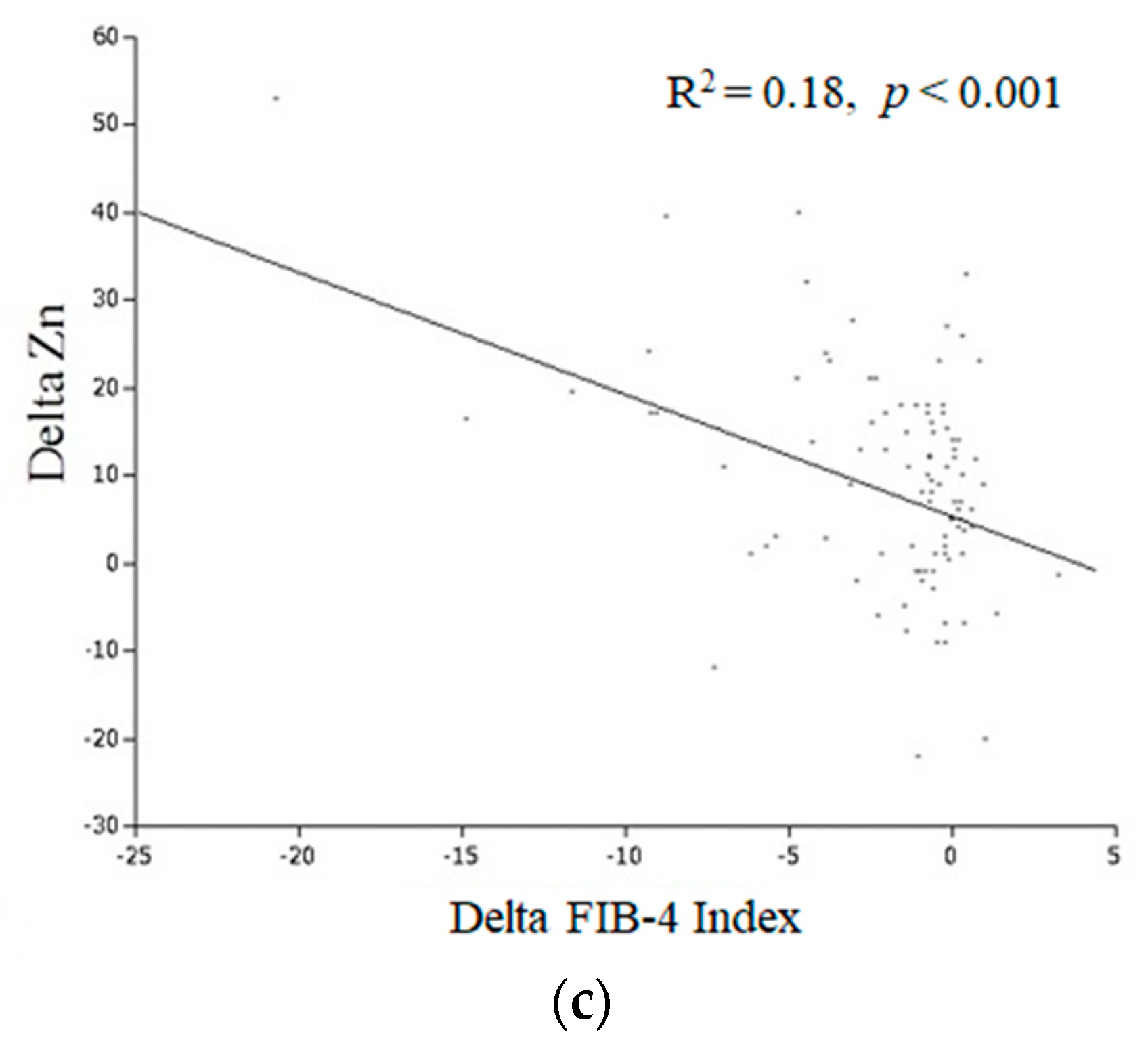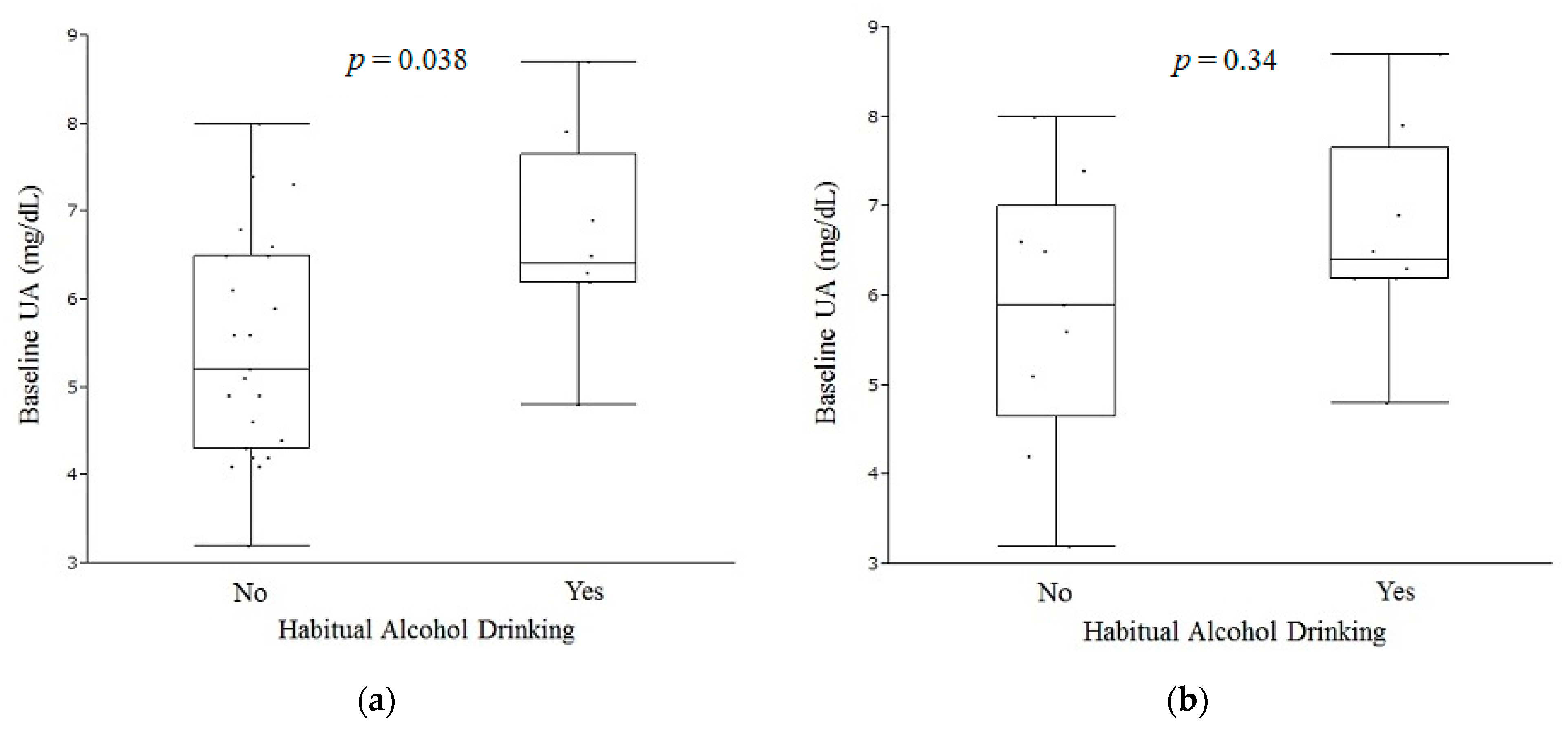Factors Attenuating Zinc Deficiency Improvement in Direct-Acting Antiviral Agent-Treated Chronic Hepatitis C Virus Infection
Abstract
:1. Introduction
2. Materials and Methods
2.1. Patients
2.2. Variables for Analysis
2.3. Statistical Analysis
2.4. Ethics
3. Results
3.1. Overall Characteristics
3.2. Risk Factors of Zinc Deficiency Two Years after SVR
3.3. Factors Related to Baseline Zn and Baseline UA
4. Discussion
5. Conclusions
Author Contributions
Acknowledgments
Conflicts of Interest
References
- Institute of Medicine (US) Panel on Micronutrients. Dietary Reference Intakes for Vitamin A, Vitamin K, Arsenic, Boron, Chromium, Copper, Iodine, Iron, Manganese, Molybdenum, Nickel, Silicon, Vanadium, and Zinc; National Academies Press: Washington, DC, USA, 2000; pp. 442–489, ISBN-10: 0-309-06949-1. [Google Scholar]
- Pazirandeh, S.; Burns, D.L.; Griffin, I.J. Overview of Dietary Trace Minerals—UpToDate. Available online: https://www.uptodate.com/contents/overview-of-dietary-trace-minerals (accessed on 12 July 2018).
- Abrams, S.A. Zinc Deficiency and Supplementation in Children and Adolescents—UpToDate. Available online: https://www.uptodate.com/contents/zinc-deficiency-and-supplementation-in-children-and-adolescents (accessed on 12 July 2018).
- Kawaguchi, T.; Nagao, Y.; Abe, K.; Imazeki, F.; Honda, K.; Yamasaki, K.; Miyanishi, K.; Taniguchi, E.; Kakuma, T.; Kato, J.; et al. Effects of branched-chain amino acids and Zinc-enriched nutrients on prognosticators in HCV-infected patients: A multicenter randomized controlled trial. Mol. Med. Rep. 2015, 11, 2159–2166. [Google Scholar] [CrossRef] [PubMed]
- Himoto, T.; Hosomi, N.; Nakai, S.; Deguchi, A.; Kinekawa, F.; Matsuki, M.; Yachida, M.; Masaki, T.; Kurokochi, K.; Watanabe, S.; et al. Efficacy of Zinc administration in patients with hepatitis C virus-related chronic liver disease. Scand. J. Gastroenterol. 2007, 42, 1078–1087. [Google Scholar] [CrossRef] [PubMed]
- Takagi, H.; Nagamine, T.; Abe, T.; Takayama, H.; Sato, K.; Otsuka, T.; Kakizaki, S.; Hashimoto, Y.; Matsumoto, T.; Kojima, A.; et al. Zinc supplementation enhances the response to interferon therapy in patients with chronic hepatitis C. J. Viral Hepat. 2001, 8, 367–371. [Google Scholar] [CrossRef] [PubMed]
- Ishikawa, T. Can Zinc enhance response interferon therapy for patients with HCV-related liver disease? World J. Gastroenterol. 2012, 18, 3196–3200. [Google Scholar] [CrossRef] [PubMed]
- Ko, W.-S.; Guo, C.-H.; Hsu, G.-S.W.; Chiou, Y.-L.; Yeh, M.-S.; Yaun, S.-R. The effect of Zinc supplementation on the treatment of chronic hepatitis C patients with interferon and ribavirin. Clin. Biochem. 2005, 38, 614–620. [Google Scholar] [CrossRef] [PubMed]
- Nagamine, T.; Takagi, H.; Hashimoto, Y.; Takayama, H.; Shimoda, R.; Nomura, N.; Suzuki, K.; Mori, M.; Nakajima, K. The possible role of Zinc and metallothionein in the liver on the therapeutic effect of IFN-a to hepatitis C patients. Biol. Trace Elem. Res. 1997, 58, 65–76. [Google Scholar] [CrossRef] [PubMed]
- Katayama, K.; Kawaguchi, T.; Shiraishi, K.; Ito, T.; Suzuki, K.; Koreeda, C.; Ohtake, T.; Iwasa, M.; Tokumoto, Y.; Endo, R.; et al. The prevalence and implication of Zinc deficiency in patients with chronic liver disease. J. Clin. Med. Res. 2018, 10, 437–444. [Google Scholar] [CrossRef] [PubMed]
- Mohommad, M.K.; Zhou, Z.; Cave, M.; Barve, A.; McClain, C.J. Zinc and Liver Disease. Nutr. Clin. Pract. 2012, 27, 8–20. [Google Scholar] [CrossRef] [PubMed]
- National Health Promotion Movement in the 21st Century (Health Japan 21), Ministry of Health, Labor and Welfare, Japan, 2013. Available online: https://www.mhlw.go.jp/www1/topics/kenko21_11/b5.html (accessed on 19 September 2018).
- Li, Y.; Chen, Y.; Zhao, Y. The diagnostic value of the FIB-4 index for staging hepatitis B-related fibrosis: A meta-analysis. PLoS ONE 2014, 9, e105728. [Google Scholar] [CrossRef] [PubMed]
- Grungreiff, K.; Reinhold, D.; Ansorge, S. Serum concentrations of sIL-2R, IL-6, TGF-1, Neopterin, and Zinc in chronic hepatitis C patients treated with interferon-alpha. Cytokine 1999, 11, 1076–1080. [Google Scholar] [CrossRef] [PubMed]
- Read, S.A.; Parnell, G.; Booth, D.; Douglas, M.W.; George, J.; Ahlenstiel, G. The antiviral role of Zinc and Metallothioneins in hepatitis C infection. J. Viral Hepat. 2018, 25, 491–501. [Google Scholar] [CrossRef] [PubMed]
- Grungreiff, K.; Reinhold, D. Zinc: A complementary factor in the treatment of chronic hepatitis C? Mol. Med. Rep. 2010, 3, 371–375. [Google Scholar] [CrossRef] [PubMed]
- Kalkan, A.; Bulut, V.; Avci, S.; Celik, I.; Bingol, N.K. Trace elements in viral hepatitis. J. Trace Elem. Med. Biol. 2002, 16, 227–230. [Google Scholar] [CrossRef]
- Omran, D.A.; Darweesh, S.K.; Fouad, H.; Mahmoud, M.; Saif, S.; Fared, A.; Hassany, M.; Mobarak, L.; El-Tahawy, M.A.; Yosry, A. Serum Zinc deficiency and its relation to liver fibrosis in chronic HCV: A real-life Egyptian study. Biol. Trace Elem. Res. 2017, 179. [Google Scholar] [CrossRef] [PubMed]
- Takahashi, M.; Saito, H.; Higashimoto, M.; Hibi, T. Possible inhibitory effect of oral Zinc supplementation on hepatic fibrosis through downregulation of TIMP-1: A pilot study. Hepatol. Res. 2007, 37, 405–409. [Google Scholar] [CrossRef] [PubMed]
- Kang, M.; Zhao, L.; Ren, M.; Deng, M.; Li, C. Zinc mediated hepatic stellate cell collagen synthesis reduction through TGF-β signaling pathway inhibition. Int. J. Clin. Exp. Med. 2015, 8, 20463–20471. [Google Scholar] [PubMed]
- Szuster-Ciesielska, A.; Plewka, K.; Daniluk, J.; Kandefer-Szerszeń, M. Zinc supplementation attenuates ethanol- and Acetaldehyde-induced Liver Stellate Cell Activation by Inhibiting Reactive Oxygen Species (ROS) production and by influencing intracellular signaling. Biochem. Pharmacol. 2009, 78, 301–314. [Google Scholar] [CrossRef] [PubMed]
- Moriyama, M.; Matsumura, H.; Fukushima, A.; Ohkido, K.; Arakawa, Y.; Nirei, K.; Yamagami, H.; Kaneko, M.; Tanaka, N.; Arakawa, Y. Clinical significance of evaluation of serum Zinc concentrations in C-Viral chronic liver disease. Dig. Dis. Sci. 2006, 51, 1967–1977. [Google Scholar] [CrossRef] [PubMed]
- Xie, D.-X.; Xiong, Y.-L.; Zeng, C.; Wei, J.; Yang, T.; Li, H.; Wang, Y.-L.; Gao, S.-G.; Li, Y.-S.; Lei, G.-H. Association between low dietary Zinc and hyperuricaemia in middle-aged and older males in China: A cross-sectional study. BMJ Open 2015, 5, e008637. [Google Scholar] [CrossRef] [PubMed]
- Zhang, Y.; Liu, Y.; Qiu, H. Association between dietary Zinc intake and hyperuricemia among adults in the United States. Nutrients 2018, 10, 568. [Google Scholar] [CrossRef] [PubMed]
- Vieira, B.A.; Luft, V.C.; Schmidt, M.I.; Chambless, L.E.; Chor, D.; Barreto, S.M.; Duncan, B.B. Timing and type of alcohol consumption and the metabolic syndrome—ELSA-Brasil. PLoS ONE 2016, 11, e0163044. [Google Scholar] [CrossRef] [PubMed]
- Hampton, S.M.; Isherwood, C.; Kirkpatrick, V.J.E.; Lynne-Smith, A.C.; Griffin, B.A. The influence of alcohol consumed with a meal on endothelial function in healthy individuals. J. Hum. Nutr. Diet 2010, 23, 120–125. [Google Scholar] [CrossRef] [PubMed]
- Thottam, G.E.; Krasnokutsky, S.; Pillinger, M.H. Gout and metabolic syndrome: A tangled web. Curr. Rheumatol. Rep. 2017, 19. [Google Scholar] [CrossRef] [PubMed]
- Yoo, T.W.; Sung, K.C.; Shin, H.S.; Kim, B.J.; Kim, B.S.; Kang, J.H.; Lee, M.H.; Park, J.R.; Kim, H.; Rhee, E.J.; et al. Relationship between serum uric acid concentration and insulin resistance and metabolic syndrome. Circ. J. 2005, 69, 928–933. [Google Scholar] [CrossRef] [PubMed]
- Himoto, T.; Masaki, T. Associations between Zinc deficiency and metabolic abnormalities in patients with chronic liver disease. Nutrients 2018, 10, 88. [Google Scholar] [CrossRef] [PubMed]
- Petta, S.; Macaluso, F.S.; Camma, C.; Marco, V.D.; Cabibi, D.; Craxì, A. Hyperuricaemia: Another metabolic feature affecting the severity of chronic hepatitis because of HCV infection. Liver Int. 2011, 32, 1443–1450. [Google Scholar] [CrossRef] [PubMed]
- Li, L.-Z.; Zhou, G.-X.; Li, J.; Jiang, W.; Liu, B.-L.; Zhou, W. Compounds containing trace element Copper or Zinc exhibit as potent hyperuricemia inhibitors via xanthine oxidase inactivation. J. Trace Elem. Med. Biol. 2018, 49, 72–78. [Google Scholar] [CrossRef] [PubMed]





| Characteristics | Values a |
|---|---|
| Total Number of Patients | 95 |
| Male, No. (%) | 44 (46.3) |
| Habitual Alcohol Drinking, No. (%) | 20 (21.1) |
| Age, years | 68.4 (9.8) |
| BMI, kg/m2 | 23.0 (3.5) |
| FIB-4 Index | 5.195 (4.588) |
| Baseline Zn, μg/dL | 70.3 (13.9) |
| HCV RNA, LogIU/mL | 6.0 (0.6) |
| WBC,/μL | 4251.6 (1606.3) |
| Hb, g/dL | 13.6 (1.5) |
| Plt, × 103/μL | 140 (62) |
| Alb, g/dL | 3.84 (0.44) |
| Tbil, mg/dL | 1.04 (0.51) |
| INR | 1.10 (0.08) |
| AST, U/L | 52.6 (33.0) |
| ALT, U/L | 50.1 (40.1) |
| ALP, U/L | 286.6 (112.5) |
| γ-GTP, U/L | 46.2 (45.1) |
| BUN, mg/dL | 14.9 (3.7) |
| Cr, mg/dL | 0.76 (0.20) |
| eGFR, mL/min/1.73 | 69.05 (14.42) |
| UA, mg/dL | 5.56 (1.33) |
| TC, mg/dL | 167.2 (30.2) |
| LDL, mg/dL | 90.3 (26.3) |
| HDL, mg/dL | 49.8 (14.1) |
| TG, mg/dL | 118.5 (164.8) |
| Glu, mg/dL | 106.0 (27.6) |
| HbA1c, % | 5.95 (0.77) |
| AFP, ng/mL | 16.91 (39.15) |
| DAA Regimens (ASV/SOF/OBV), No. | 50/41/4 |
| Parameters | OR (95% CI) | Chi-Square Test p Value | OR (95% CI) | Multivariate Analysis p Value |
|---|---|---|---|---|
| Baseline Zn < 65 μg/dL | 9.47 (2.73–32.86) | <0.001 | 10.56 (3.00–45.27) | <0.001 |
| FIB-4 Index > 3.25 | 15.38 (1.94–122.13) | 0.001 | ||
| Plt ≤ 120 × 103/µL | 5.17 (1.53–17.53) | 0.005 | ||
| Alb ≤ 3.5 g/dL | 10.21 (3.06–34.07) | <0.001 | ||
| INR > 1.1 | 7.08 (1.86–26.90) | 0.001 | ||
| AST > 40 U/L | 5.45 (1.44–20.63) | 0.005 | ||
| UA > 5.5 mg/dL | 8.80 (1.87–41.32) | 0.001 | 9.99 (2.31–71.31) | 0.001 |
| TC ≤ 160 mg/dL | 7.47 (1.96–28.42) | 0.001 |
© 2018 by the authors. Licensee MDPI, Basel, Switzerland. This article is an open access article distributed under the terms and conditions of the Creative Commons Attribution (CC BY) license (http://creativecommons.org/licenses/by/4.0/).
Share and Cite
Ko, Y.-L.; Morihara, D.; Shibata, K.; Yamauchi, R.; Fukuda, H.; Kunimoto, H.; Takata, K.; Tanaka, T.; Inomata, S.; Yokoyama, K.; et al. Factors Attenuating Zinc Deficiency Improvement in Direct-Acting Antiviral Agent-Treated Chronic Hepatitis C Virus Infection. Nutrients 2018, 10, 1620. https://doi.org/10.3390/nu10111620
Ko Y-L, Morihara D, Shibata K, Yamauchi R, Fukuda H, Kunimoto H, Takata K, Tanaka T, Inomata S, Yokoyama K, et al. Factors Attenuating Zinc Deficiency Improvement in Direct-Acting Antiviral Agent-Treated Chronic Hepatitis C Virus Infection. Nutrients. 2018; 10(11):1620. https://doi.org/10.3390/nu10111620
Chicago/Turabian StyleKo, Yi-Ling, Daisuke Morihara, Kumiko Shibata, Ryo Yamauchi, Hiromi Fukuda, Hideo Kunimoto, Kazuhide Takata, Takashi Tanaka, Shinjiro Inomata, Keiji Yokoyama, and et al. 2018. "Factors Attenuating Zinc Deficiency Improvement in Direct-Acting Antiviral Agent-Treated Chronic Hepatitis C Virus Infection" Nutrients 10, no. 11: 1620. https://doi.org/10.3390/nu10111620
APA StyleKo, Y.-L., Morihara, D., Shibata, K., Yamauchi, R., Fukuda, H., Kunimoto, H., Takata, K., Tanaka, T., Inomata, S., Yokoyama, K., Takeyama, Y., Shakado, S., & Sakisaka, S. (2018). Factors Attenuating Zinc Deficiency Improvement in Direct-Acting Antiviral Agent-Treated Chronic Hepatitis C Virus Infection. Nutrients, 10(11), 1620. https://doi.org/10.3390/nu10111620





